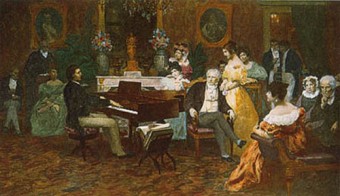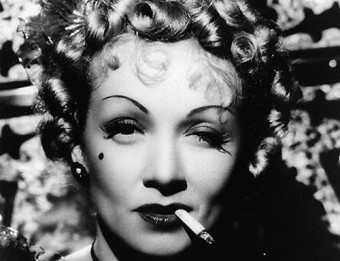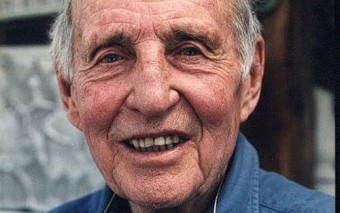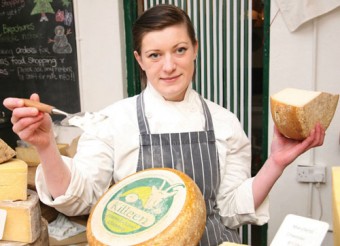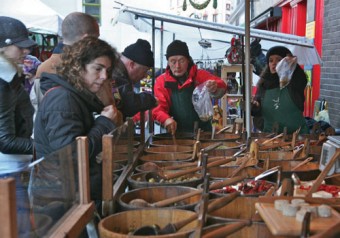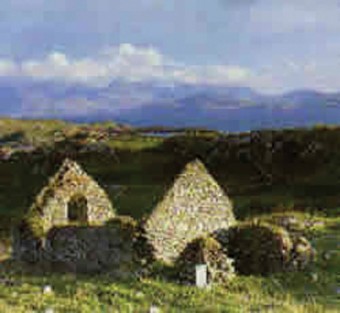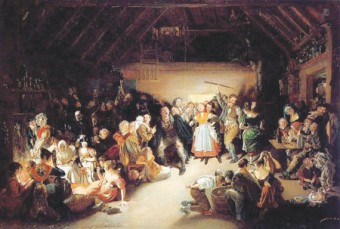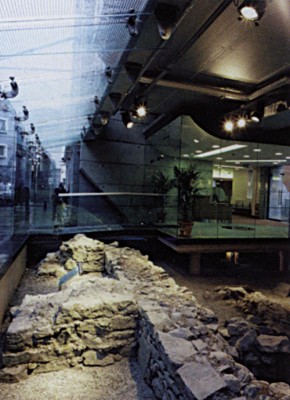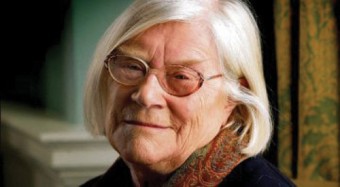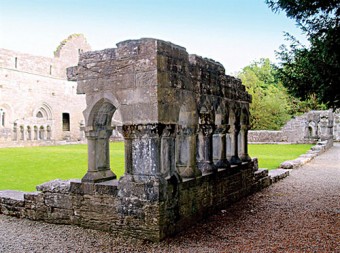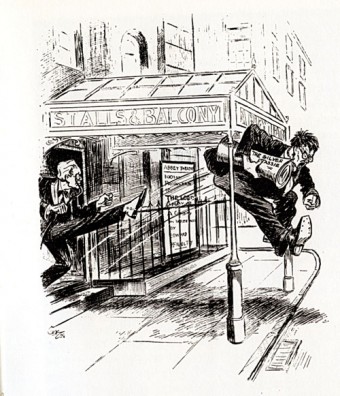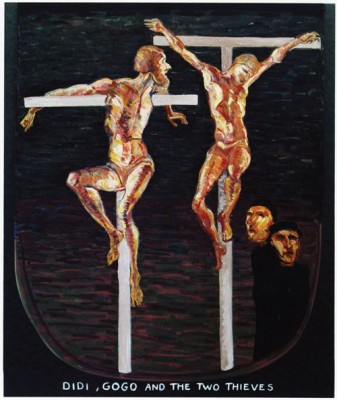No Recipe
Thu, Dec 30, 2010
Gerry Galvin was born in Drumcollogher, Co Limerick in 1942 and now lives in Oughterard, Co Galway. He is a chef and former restauranteur at the renowned Drimcong restaurant, and is the author of two cookbooks, The Drimcong Food Affair and Everyday Gourmet. He is a columnist for Organic Matters magazine. His poetry and short stories have been published widely in newspapers and magazines in both the UK and Ireland. This poem is from his latest collection No Recipe (Doíre Press, €12).
Read more ...The Irish Boycott
Thu, Dec 30, 2010
The preservation and the teaching of the Irish language has often provoked a passionate defence, no more so than on the island of Tawin. At the beginning of the last century a fierce row erupted when local people felt that Irish was not being taught in their local school, and took matters into their own hands. Children were kept away from the school, and money was raised to have them taught separately in their own language. It became a cause celibre attracting the support of such nationalist figures as Roger Casement. The story has been well told by Nollaig Mac Congáil in the current issue of the Journal of the Galway Archaeological and Historical Society (Volume 62) which I will come back to next year.
Read more ...The Wild Banker - Gilles McBain
Thu, Dec 30, 2010
Last October 7, the renowned playwright and short story writer John Arden celebrated his 80th birthday. The occasion was commemorated in the Town Hall in the appropriate way. Actors read extracts from his plays, musicians played, and John, with his valiant partner Margaretta D’Arcy, performed. It was a memorable evening. Film director Bob Quinn could not contain himself. He brought the house down by singing the following ditty, which would make a good party piece this Christmas.
Read more ...A royal tribute to the 'Poet of the Piano'
Thu, Dec 30, 2010
Every Sunday evening during the month of August, a pianist is invited to play Chopin's piano. The piano is not a shiny, black grande, but an honest-looking, workman-like upright. The sort you'd see in any home where someone was learning to play this majestic musical instrument.
Read more ...CA Lejeune, the Observer's first film critic, enjoys a very brief encounter with Marlene Dietrich
Thu, Dec 30, 2010
My friend John Kilkelly from Ballina gave me this beautifully observed article on the difficulties endured by journalists and the film studios trying to placate a famous star.
Read more ...The challenge of Crusheen Bridge
Thu, Dec 30, 2010
Not everything was wasted during the Celtic Tiger years. Galway has benefited greatly from the motorway to Dublin, as well as the Gort by-pass, which gives motorists a clear run to Limerick on the impressive M18. No one will be sorry to see the end of the Crusheen right-angled turn under an impossible railway bridge. Artics needed the whole road to make the turn, causing delays and gasps of incredulity at the narrowness and the danger of it all.
Read more ...Christmas shopping without the tears
Thu, Dec 16, 2010
Christmas has crept up again. A time for joy to the world, and peace among men or, conversely, of panicked late night shopping, and the anxiety that accompanies the realisation that you have exactly seven minutes before shops close. It's Christmas Eve, and you are empty-handed (aside from, if you are like me, a few little presents that you accidentally got for yourself). That perfect gift has eluded you once more, and all the time you thought you had, as you browsed nonchalantly, has vanished into the ether. Aimless wandering is one thing, but the real challenge comes when setting out with a specific, particularly hard to please person in mind. This can lead to blind panic, often resulting in decidedly bad choices. I aim to, at best, give something of practical use to the recipient, preferably something that they wouldn't buy for themselves, or, at the least (and this is perhaps the last refuge of the desperate), to knock a laugh out of them. Some notable failures include impulsively bought jewellery, assorted DVDs (which now lurk, mockingly, on the shelf, still clad in their original cellophane), and a festive geansaí, which, upon opening, was immediately earmarked for return. One year out of frustration and laziness I bought a friend a book that I suspected she would never open, but that I wanted to read. After an appropriate waiting period I 're-gifted' it to myself, and everyone was happy – I got the brownie points and the goods. This year I hope to avoid the blunders of the past, and furnish my nearest and dearest with things that will, without hyperbole, change their lives for the better.
Ireland has not sunk so low into the depths of depression that we are obliged to give each other canned goods and toilet roll. Yet. With this in mind I paced the streets, paying particular attention to quirky, Irish-made things. A stall, helpfully named 'Galway Made' in the Eyre Square market seemed like a good place to start. Three Galway-based artists share the stall, and all have high quality, imaginative work. Wicked Candles produce wax wall-hangings and vases (€22), tealight holding wax lanterns, as well as the more traditional hand-poured candles (€6-20). Blankbeauty do retro crockery – fine china cups and saucers, mugs (€8), jugs and serving dishes with 70s vintage designs. And Aoife McGough of Seodra Bán makes jewellery from (cow) bone, and also offers classes where you can make your own piece, design and fashion it with your own fair hand in a one-day class (€65 per person, €120 for two people), and vouchers are available if you know anyone who has a deep-seated, though as yet unfulfilled desire to make their own jewellery (www.seodraban.ie and www.bonecarving.ie).
Read more ...There is no need for a £250 Heston Blumenthal pudding this Christmas
Thu, Dec 09, 2010
While most of us will be readying ourselves for the tried and tested turkey/ham/spuds Christmas Day combination, there are now more alternatives available in Galway than ever before. Our markets – both the St Nicholas' weekly market and the 'Christkindlmarkt' in Eyre Square – our restaurants and food emporiums now offer a broad array of options for those of us not brimming over with joie de vivre at the prospect of a week of heavy duty turkey consumption.
Read more ...Forget our woes, it’s Galway markets that pay dividends...
Thu, Dec 02, 2010
Thanks -be -to -the -hooky that when we speak about markets in Galway we are not talking about the financial markets that have us all singin’ the blues, but about our successful food, and craft markets that are money winners for the city. The Galway Christmas Continental market on Eyre Square is an astonishing success. On the weekend it opened more than 70,000 people walked through it. Those high numbers have kept up. Last Saturday the clickers counted more than 25,000, and admit they only managed to count about 75 per cent.
Read more ...The mystery of little Eliza Murphy of Island Eddy
Thu, Nov 18, 2010
Among the serious articles in the current edition of the Galway Archaeological and Historical Society*, renowned for its hard facts and forensic research, is a surprising story as tender as its subject. It concerns two people, one a child of 17 months, the other a sculptor, who, up to now, have been unknown. Who are they?
Read more ...Our monstrous weather and finances
Thu, Nov 11, 2010
In the midst of our miserable weather, and dire financial troubles the series of ‘unfortunate’, or at least most unusual, events continued last year. Stringing them all together, as Dr Kieran Hickey does in his interesting book* reminds us that little old Ireland, blessed and loved by the saints, a ‘nation cradled in the arms of St Patrick’ (as I was taught in national school), is, alas, not excluded from strange geophysical events such as extreme weather conditions, including volcanoes and earthquakes, as we may have once believed. Although it was extremely rare for all these events to happen in the same year, I am sorry to say that having spoken to Dr Hickey this week, we’d better batten down the hatches, and prepare for a worse walloping to come. Just over 200 years ago the weather gave Mary Shelley monstrous dreams...but more of that in a moment.
I think I must have been too preoccupied by the our lovely country sinking in the quagmire of incessant rain, floods and financial gloom to notice that on Wednesday February 3 a meteorite, described by many as a strange fireball ‘very bright green with an orange tail’ streaked across the sky over counties Kerry, Cork, Limerick, Galway, the midlands, Donegal, Derry, and Tyrone. It probably fell into a river or bog in County Armagh or Lough Neagh. It has never been found. Dr Hickey saw it as he left his office at NUIG on his way to his car. At first he thought it was a firework, but as it continued its fiery journey northwards, he knew it was a meteorite. How big it was is impossible to say. It could have been a big as a house. But as it entered to earth’s atmosphere, it disintegrated rapidly as it travelled from south to north. In Roman history meteorites have presaged grim tidings for us poor mortals on earth.
Read more ...The ghost of Sir Walter Scott at Hallowe’en
Thu, Oct 28, 2010
During the first three decades of the 19th century the parish priest of Blarney (north of Cork city) was the affable Fr Mat Horgan. He was the epitome of the traditional scholar-priest. He was a poet and antiquarian, a supporter of Cork university, an advocate for social reform, his hero was Daniel O’Connell, and he spoke Latin and Irish effortlessly. He lived at Ballygibbon (later named Waterloo after a bridge was built there in the month of the famous battle), and built a model of an ancient Round Tower, which can still be seen from the old Limerick to Cork road. But Fr Mat’s great gift was his love and generosity for bringing people of all classes together for dinners, parties and celebrations in a huge barn adjoining his home.
Read more ...Architects - making their mark
Thu, Oct 21, 2010
Galway prides itself on being a medieval city. Thanks to some good development during the past 30 years or so, much of our ancient city landscape has been highlighted. Yet compared to Kilkenny, we are only at the tuppence-halfpenny stakes when it comes to physical history. But one new building in particular has done more than anything else to highlight the beginning of commercial Galway, and the growth of the town. I am referring to that deceptively simple projection of a 13th century Norman hall into the public domain at Druid Lane, off Quay Street. Designed by Michael Cadden at the Office of Public Works, using clean-lined modern architecture, the archaeological site is left as it was unearthed, and is presented behind a large glass wall. Uniquely the public is offered total immersion. Not only can we view the site, but there is provision for a public walkway over the site. But more of that in a moment.
Read more ...‘The sharpness of the factory girl’s tongue’
Thu, Oct 14, 2010
In the late 1980s a number of innovative ideas were introduced to industry and business, that cleared the runway for the Celtic Tiger take off. The one that made great sense, and had an energy about it, was the inventory strategy known as just-in-time. A Japanese idea that spread through Europe like a Spanish forest fire in a heat wave. Instead of stockpiling raw products for manufacture or for sale (with all the attendant headaches of storage costs, temperature, accounting, etc, etc,) the management skill was to wait until stocks were low, and then pick up the phone and make sure your supplier gave you exactly what you needed at the right time, in the right place, and the exact amount just-in-time. Suddenly, everyone was doing it. Suppliers were kept on their toes, trucks delivered through the night, and a bit of excitement was injected into the work place.
Excitement of a different kind was felt among the employees on the factory floor. Galway poet Rita Ann Higgins remembers when suddenly there were ‘jobs aplenty in Mervue Industrial Estate’. As a young girl, ‘when the only priority was washing the hair, and slapping on layers of makeup’, she rushed with all the others to join up. Soon she was hooked ‘on the chatter from the girls in the shirt factory, the stories about the boys and dance halls, and what went on in the backs of old cars after dances. The kissing stories, the telling-all stories. Someone was ‘such a ride’, someone else was ‘the town bike’. Factory lore was enhanced with nods and glances, and the internal rhythm of licentiousness was palpable. ‘In reply to the question, “What was he really like?” the ultimate put down was when a little finger was exhibited and crooked into the shape of a worm. The repartee from the factory girls was honed and blade-like. No nearby male was exempt from the sharpness of the factory girl’s tongue’.
Read more ...Not everybody liked Lady Gregory
Thu, Sep 30, 2010
I find it hard to imagine that not everyone liked Lady Augusta Gregory of Coole Park. What few readers there are of the Diary, I am told, sigh with exasperation when they see her name appear. They know that I will eulogise endlessly about how her home at Coole became a ‘workshop’ for writers, poets and artists during those exciting days at the beginning of the last century, leading to such remarkable talents as WB Yeats, John M Synge, Sean O’Casey and others to stand as giants on the European literary stage. She was the co-founder of the Abbey Theatre, its director and organiser during its shaky early days. She was a substantial playwright, journal keeper, folklorist, scholar, etc, etc, and, in my opinion, this amazing Galway woman never got the recognition she deserved.
Read more ...A Christian heritage lost in ivy
Thu, Sep 02, 2010
Last Easter Sunday, I was privileged to attend a dawn Mass, near Cong, on the Lough Corrib shore. About 300 people stood close to a blazing fire, as daybreak slowly lifted the darkness revealing the wide expanse of water, its wooded islands, and in the distance, the mountains of the Maam valley. It was perfectly silent and peaceful. Fr Ray Flaherty welcomed us with these opening words: ‘It was here many saints like Meldon, Fursey, Brendan and Feichin made their homes of peace and prayer. There are many sanctuaries scattered today in ruins along the shores of this lake, silent ruins where the soft tones of bells and the church’s solemn chant floated over the waves...’
The Mass was celebrated within sight of Inchagoill, the largest of the 145 islands on our lake. Inchagoill has been inhabited for approximately 1,400 years. The last resident was Tom Nevin, the caretaker for the Guinness family, who maintained the pathways and graveyard. Large boats were being built on the island as recently as 1956. But the Nevin family house is an overgrown ruin now, and its remains lie close to two of the most beautifully preserved early Christian churches, that even today radiate a presence of peace and spirituality.
Read more ...A missed opportunity
Thu, Aug 19, 2010
There is often more drama in the board room of the Abbey Theatre, Dublin, than what is presented on its stage. Following a famous conversation in Doorus House, Kinvara, one rainy afternoon in 1897, Lady Augusta Gregory of Coole Park, Edward Martyn of Ardrahan, and the young poet WB Yeats agreed to set up the Irish Literary Theatre. Theatre at the time was mainly influenced by the popular British music hall variety; and melodrama. It was agreed that day in Co Galway that the new Irish theatre would ‘embody and perpetuate Irish feeling, genius, and modes of thought’.
Read more ...The last free Chieftains of Ireland
Thu, Jul 29, 2010
Some weeks ago I wrote that probably the greatest muster of the Irish Gaelic lords that ever gathered on a battlefield took their place on either side at Knockdoe, Co Galway, on August 19 1504. The O’Donnells and the O’Neills, from their great northern fiefdoms, fought for law and order on the side of the Earl of Kildare who successfully imposed the king’s rule on his rebellious and quarrelsome son-in-law the Earl of Clanricard, Ulick de Burgh (Burke) of Claregalway castle. Ulick’s marriage to Kildare’s daughter, and his disregard for her, gave the Earl a personal reason for the battle; but his allies were equally anxious to display their loyalty to King Henry VII, the undisputed king of England after the protracted and bloody Wars of the Roses.
Yet within 30 years, the house of Kildare was in revolt against the crown. The result was that the Earl of Kildare’s grandson, Tomás an tSíoda, was hanged and beheaded in the Tower of London. While at Tyburn his five uncles were partly hanged, cut down, had their intestines drawn from their bodies, thrown into a fire, before finally, and mercifully, hacked into four pieces with an axe. Rebellion against the English crown, much of it calamitous for the people involved, continued sporadically until the Flight of the Earls on September 14 1607, a significant moment in Ireland’s history.
Read more ...Life is absurd - but let’s get involved
Thu, Jul 22, 2010
This year’s Galway Arts festival succeeds yet again in giving some insight into the minds of remarkable artists whose personal magic interprets our world. These include international journalists Niall O’Dowd, John Lancaster, several writers including Bret Easton Ellis, and the renowned theatre and opera director Sir Peter Hall. On Saturday afternoon, the playwright and poet Frank McGuinness teased out some paths through the labyrinthine mind of Ireland’s leading painter Brian Bourke.
Read more ...